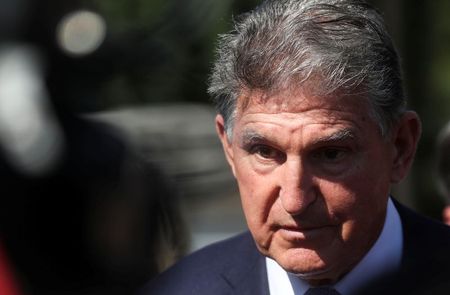By Jarrett Renshaw and Timothy Gardner
WASHINGTON (Reuters) – Democrats are close to finalizing a plan supported by U.S. Senator Joe Manchin that would boost tax credits for power plants that capture carbon, as the White House courts him to pass a multi-trillion spending plan, two sources said.
The carbon sequestration tax credit, which rewards industries for installing equipment to capture carbon dioxide emissions and store them underground, is a crucial part of the “Build Back Better” bill being crafted in Congress, which aims to tackle the impacts of climate change by pushing companies to curb greenhouse gases.
Manchin, a moderate Democrat from West Virginia, the second biggest coal-producing state, has been a key obstacle in getting the spending plan passed through Congress. He has said he wants Democrats to trim it from $3.5 trillion to about $1.5 trillion and wants a large say in the energy provisions.
The plan being discussed would boost the so-called “45Q” tax credit from $50 a metric ton to at least $85 a ton for power plants, including those fueled by coal and natural gas. Last week lawmakers hammered out an agreement to raise the tax credit for industrial plants such as those making cement, steel and biofuels.
As progress is made on 45Q, Democrats are also trying to reverse Manchin’s opposition to a wider White House proposal to decarbonize the nation’s power grid, the sources said.
The Clean Energy Payment Program (CEPP) would reward utilities who add more clean energy capacity like solar and wind power, and fine those who do not.
A hike in the 45Q credit value is intended to spur investment in carbon capture, seen by many as a vital tool in combating climate change, after poor economics and technological issues sank early projects.
If passed, both the tax credits and CEPP could go a long way to help President Joe Biden achieve his climate goals of decarbonizing the power grid by 2035 and the wider economy by 2050.
The two initiatives are intertwined – both politically and commercially – and negotiators and observers say nearing an agreement on the tax credits is a good sign.
“It’s a sequencing thing. If we get the first part done, it makes it easier to get the payment plan portion done,” said one source familiar with the negotiations.
The White House did not immediately respond to a request for comment.
MANCHIN’S LONG-STANDING OPPOSITION TO CEPP
Under CEPP, utilities would receive payments from the Energy Department if they increase clean energy supplies by 4% annually. If a supplier fails to meet the 4% targeted increase, it would owe $40 per megawatt hour for any shortfall.
Negotiators are considering a number of ideas, such as lowering the target increase to 3% or adjusting other “dials” to make it easier for power companies to comply.
Manchin, whose office did not comment for this story, has been publicly critical of the plan, arguing the utility industry is already transitioning to clean energy and it would be waste of taxpayer money.
“The transition is happening. Now they’re wanting to pay companies to do what they’re already doing. It makes no sense to me at all for us to take billions of dollars and pay utilities for what they’re going to do as the market transitions,” Manchin told CNN in September.
Critics say Manchin is protecting the coal and natural gas industry that are economic drivers in his home state, and benefit his family. Manchin founded the private coal brokerage Enersystems in 1988 and still owns a big stake in the company, which his son currently runs.
In 2020 alone, Manchin earned nearly $500,000 of income from Enersystems, and he owns as much as $5 million worth of stock in the company, according to his most recent financial disclosure.
Lee Beck, the international director for carbon capture at the nonprofit Clean Air Task Force, said both policies need to be included in the reconciliation bill, as 45Q supports a specific technology, while the CEPP would bring about holistic decarbonization of the power sector, a top U.S. source of emissions.
“It’s really a portfolio approach, both of these pieces work together for decarbonization, one is for innovation, one is more comprehensive climate policy,” Beck said.
(Reporting By Jarrett Renshaw and Timothy Gardner; Editing by Heather Timmons and Marguerita Choy)





